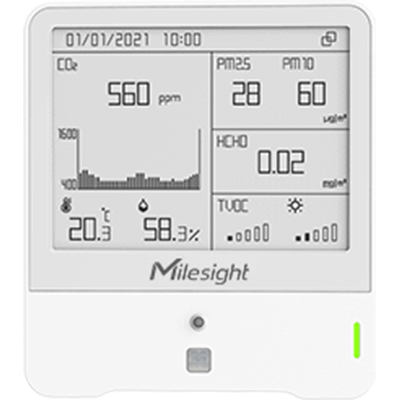What Is an Environmental Sensor?

An Environmental Sensor is a sensor used to detect and quantitatively measure environmental information in the surrounding environment.
Environmental Sensors are used to measure various environmental parameters such as temperature, humidity, light intensity, CO2 concentration, atmospheric pressure, noise, etc., as well as to detect the human body.
Recently, there are products that incorporate multiple environmental sensors in a small USB-type package to improve the convenience of evaluation.
Uses of Environmental Sensors
Environmental Sensors are sometimes used by themselves to display information, but more often they are used to detect external environmental information to control other devices or equipment.
Examples of specific uses include devices that require temperature and humidity control, automatic doors and lighting that are activated by approaching humans, automobiles, aircraft, and detection of exhaust gases and occupants.
In automobiles, the purpose is to measure outside air, interior temperature and humidity, and solar radiation to determine the temperature and airflow rate of air conditioners.
In aircraft, they are also used for the purpose of controlling the attitude of the aircraft.
Principle of Environmental Sensors
The principle of environmental sensor is to convert information to be detected, such as temperature and humidity of the environment, into electrical signals by utilizing various physical phenomena, and to grasp them as quantitative values.
Environmental sensors generally target external inputs (weather information, light, obstructions, sound, etc.), and many sensors have the ability to amplify and output weak signals or convert measurement units.
A typical environmental sensor, the highly versatile temperature/humidity sensor, is often integrated as a device, but temperature and humidity are measured separately, and temperature is generally detected by a thermocouple or thermistor. Thermocouples utilize the potential difference between two different metal wires. Thermistors can detect temperature with a resistive element composed of a metal wire and a metal oxide semiconductor.
Among them, NTC thermistors are widely used because they have a negative correlation in which the mobility of electrons increases and resistance decreases as temperature rises, making the relationship between temperature and resistance easy to understand.
Humidity sensors measure the amount of water vapor in the air and convert it to humidity as a ratio to the maximum amount of water vapor that can exist in the air.
There are two types: one that measures changes in semiconductor capacitance and the other that measures changes in semiconductor resistance. Resistance detection is less expensive, but it should be noted that the measurement accuracy is inferior to that of the capacitance type.
Other types of environmental sensors include optical and illuminance sensors that detect light such as infrared and ultraviolet rays. These sensors use photodiodes that utilize the photoelectric effect and photoresistors compatible with various wavelengths to detect light intensity. Most of these sensors also detect infrared light emitted from the human body.
Other Information on Environmental Sensors
1. Environmental Sensor as an Indicator of Arousal
CO2 sensors, one type of environmental sensor, are sometimes used as an indicator of arousal in a room. CO2 sensors mainly measure the concentration of carbon dioxide generated by human respiration, and can be used in places where many people gather, such as conference rooms and hospital waiting rooms.
In places where many people gather, such as classrooms, if the concentration of carbon dioxide is too high, it is said to affect the ability of people to concentrate, which is expected to improve work efficiency.
2. Miniaturization of Environmental Sensors
Environmental Sensors are also becoming smaller and smaller. Some of the smallest environmental sensors are less than 1 cm in size, and can be used in various fields such as medicine, agriculture, and manufacturing.
There are also USB-type environmental sensors. They are smaller than ordinary USB memory sticks and can be powered by USB for constant operation, and can be connected to a network via USB or Bluetooth for transmission of measurement data.
However, when connected to a PC’s USB port, the temperature sensor may not be able to measure temperatures correctly due to the heat of the PC itself, so it is recommended to use an extension cable.